Quick Facts About Buying a Used Ford F-150
- 2021 to 2024 Ford F-150 trucks are the best choice if you’re looking to save a few thousand dollars but still want the latest tech, safety, and design.
- The Ford F-150 has been the best-selling truck for about 50 years.
- The F-150, with its numerous engine, cab, and bed configurations, consistently has class-leading towing and payload figures.
The best-selling vehicle in America for the past several decades isn’t a car; it’s the Ford F-150 pickup. With numbers like these, it only makes sense for anyone shopping for a pickup truck to consider one of the many used Ford F-150s still on the road.
Long regarded for its rugged design, strong engines, and top-line trims, which border on near-Lincoln levels of luxury, the F-150 checks a lot of boxes for pickup truck buyers. It consistently holds best-in-class towing and payload numbers and boasts a nearly infinite combination of bed lengths, cabin sizes, axle ratios, and options. Although the first F-Series pickup dates back to 1948, the first F-150 debuted in 1973. This review will focus primarily on the 1997 and newer trucks.
A word to first-time pickup buyers: While the V6 base models are suitable for light-duty hauling, anyone with trailering or heavy payload requirements should be shopping for the more powerful V8 trims or the turbocharged EcoBoost models.
- What Are the Best Years to Buy a Used Ford F-150?
- Ford F-150 By Generation: Which Should You Buy?
- What Is the Most Weight a Ford F-150 Can Tow and Haul?
- What Is the Difference Between a Ford F-150 and an F-250?
- What Is the Longest Bed I Can Get on an F-150 SuperCrew?
- Are the Ford F-150s With Aluminum Body Panels Expensive to Repair?
- What Are the Issues to Watch Out for With a Ford F-150?
- How Does the Ford F-150 Stack Up to the Competition?
- Is the Ford F-150 a Good Vehicle?
What Are the Best Years to Buy a Used Ford F-150?
If you’re looking to save a few thousand dollars but still want the latest tech, safety, and design, a 2021 through 2024 F-150 is the best choice. A close runner up is the 13th generation trucks built for model years 2015 to 2020. These years come nicely equipped. Both the V8 and 3.5-liter EcoBoost engines are strong performers, with the EcoBoost being the best choice for heavy towing and power. However, both engines do have a few issues that can develop as the mileage climbs, especially if they were not properly maintained by the previous owner. Areas to watch for when buying used include issues with the cam phasers, carbon buildup, and stretched timing chains. The best F-150 for the budget-minded is the 2004-2008 truck.
See Ford F-150 pickups for sale near you.
Ford F-150 By Generation: Which Should You Buy?
14th Generation: 2021-Current
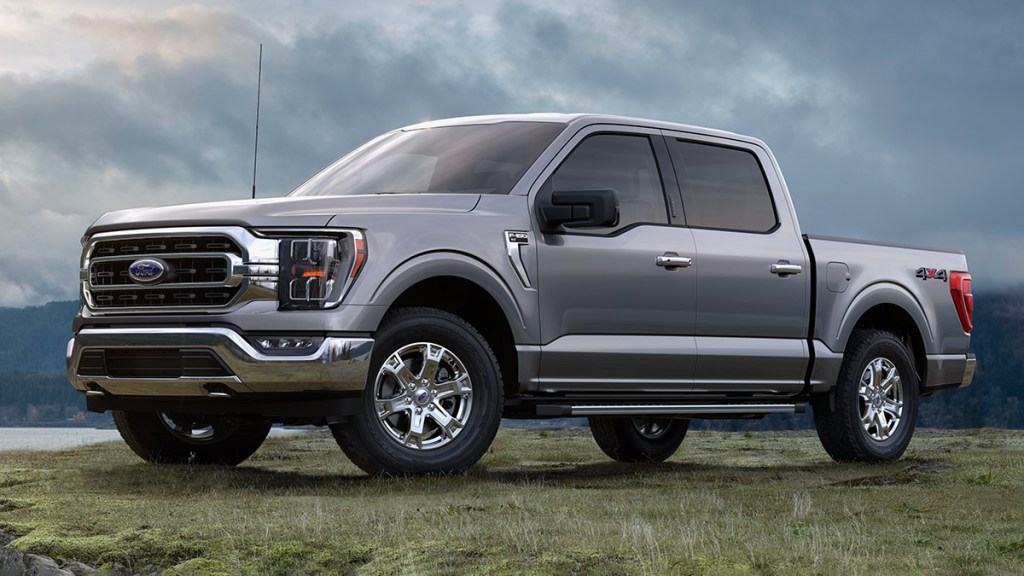
The latest F-150 builds off the success of the previous generation by offering better powertrain options, like a hybrid engine, a better interior, and more advanced electronics. Towing and payload figures increase, the Raptor off-roader gets even better, and a new Tremor model debuts. The F-150’s interior sees great improvement in both design and functionality, offering an available 12-inch touchscreen and the latest SYNC 4 infotainment system. New features like the Pro Power Onboard inverter provide power for daily worksite tools, and Ford’s available BlueCruise offers hands-free driving on hundreds of thousands of miles of highways.
Model Year Changes:
2024: A styling upgrade coincides with some new tech, a new 2.7-liter EcoBoost base engine, and a new multi-way tailgate.
2023: New Raptor R.
2022: All-electric F-150 Lightning debuts.
See 2021 to current Ford F-150 pickup trucks for sale near you.
13th Generation: 2015-2020
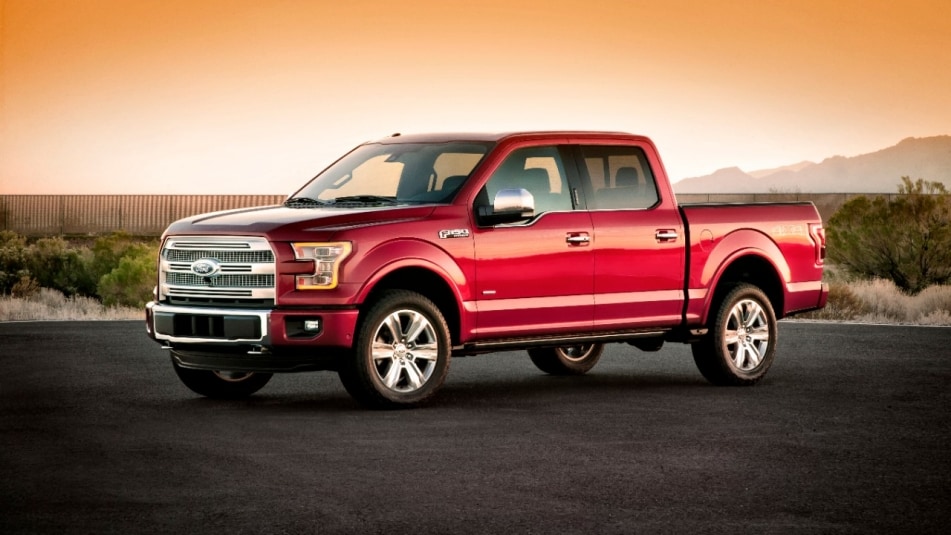
The 13th-generation F-150 marks another major milestone in the truck’s story. A used version of this truck will give you most of the features available on a new F-150. The most noticeable improvement is using aluminum across the F-150’s body panels, although the frame and firewall remain high-strength steel. A loss of nearly 700 pounds allows the F-150 to dominate its Chevrolet and Ram rivals in fuel economy, towing, and payload. However, some owners and competitors point out how easy it is to damage the F-150’s aluminum bed panels. Ford counters that most pickups use truck bed liners to eliminate this worry. The 2015 to 2020 F-150s are safer and more technologically advanced than the 2009 to 2014 versions, with features such as blind-spot monitoring, lane-keeping assist, and adaptive cruise control available on some trims. The infotainment system gets upgraded to the SYNC3, which addresses the many bugs and issues with the old MyTouch. Power for these generations continues to come from a series of 6- and 8-cylinder gasoline engines, turbocharged 2.7-liter and 3.5-liter EcoBoost V6s, and a 3.0-liter turbodiesel V6.
Model Year Changes:
2020: Co-Pilot360 driver assist technologies is made standard on Lariat, the XL gets more option packages, and the diesel engine joins more trims.
2019: A 3.0-liter turbodiesel joins the lineup while the CD player gets the heave-ho.
2018: A new 3.3-liter V6 arrives.
2017: A new 10-speed automatic debuts, and the 3.5-liter EcoBoost gets more power.
2016: SYNC 3 infotainment upgrade.
See 2015 to 2020 Ford F-150 pickup trucks for sale near you.
12th Generation: 2009-2014
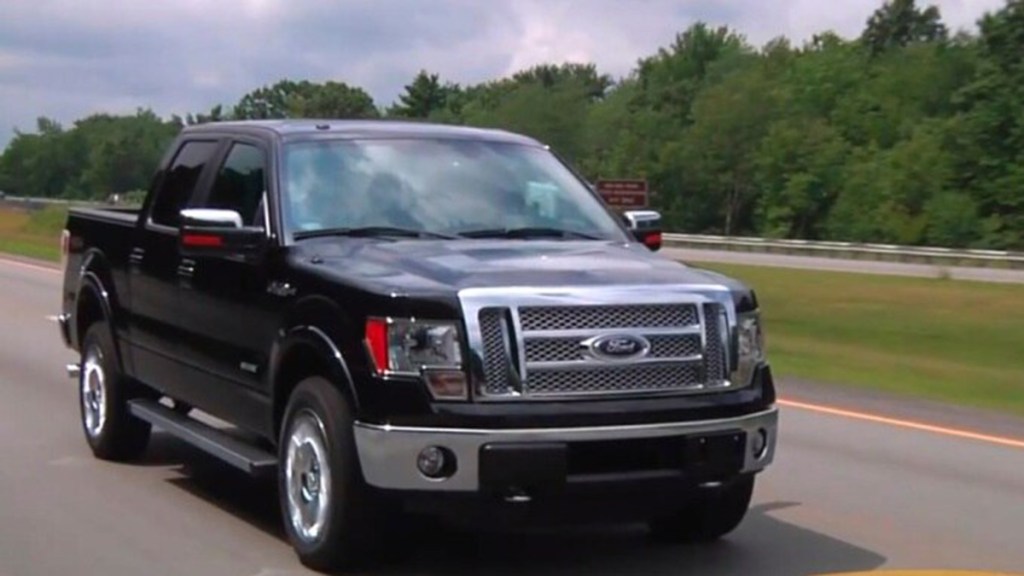
The 12th generation sets the bar high for the competition. This version, which runs through the 2014 model year, includes a beefed-up frame, greater towing ability, and a standard V8 engine. The F-150’s cab grows larger, accommodating passengers and stuff with more storage compartments and places to put Big Gulps. Regular Cab models lose their rear doors, but SuperCab models gain rear windows that can be raised and lowered. Ford’s SYNC infotainment system arrives, as do necessary features such as Bluetooth and USB auxiliary inputs. The F-150 offers several unique firsts, including an integrated stepladder built into the tailgate, trailer sway control, and an available computerized system for keeping track of work tools and equipment.
Safety improvements include electronic stability control and front side-impact and side-curtain airbags. 2009 sees the addition of a new, top-of-the-line luxury Platinum trim.
Model Year Changes:
2014: The F-150 gets a revised grille, HID headlights on the XLT, and more options.
2013: MyFord touch arrives while the Raptor and SX4 gain standard hill-descent control.
2012: A new automatic 4×4 system joins the Lariat and higher trims along with a few visual updates.
2011: Four new engines mark the big changes for the 2011 Ford F-150: a 3.7-liter V6, 5.0- and 6.2-liter V8s, and a twin-turbocharged 3.5-liter EcoBoost V6. A 6-speed automatic is standard on all F-150 models for the first time.
2010: MyKey is made standard on all but the base XL. King Ranch and Platinum models get more standard features, while the high-performance off-road SVT Raptor debuts with an available 411-hp 6.2-liter engine.
See 2009 to 2014 Ford F-150 pickup trucks for sale near you.
11th Generation: 2004-2008
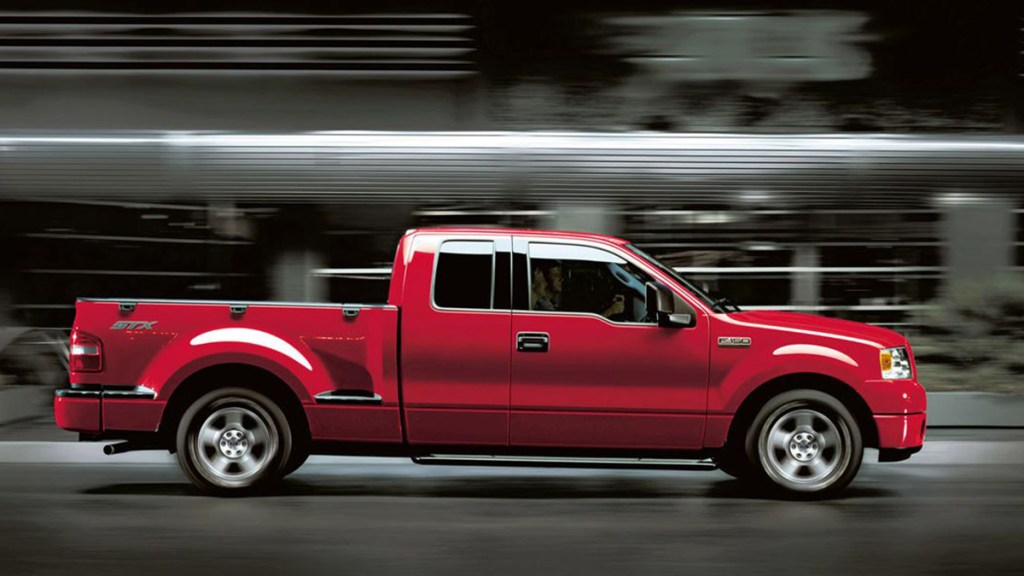
The 2004 redesign brings a vastly better F-150, and this is the one we’d recommend to buyers on a budget. This generation runs through the 2008 model year and features a return to traditional F-150 styling. It’s also better constructed, which results in much better crash test ratings. A fully boxed frame improves the truck’s rigidity and structural integrity, and a revised rear suspension helps eliminate wheel hop and improve the overall ride. The F-150’s bed gets deeper and wider than the previous generation.
Other improvements included disconnecting front wheel hubs on 4×4 models and a 3-valve-per-cylinder head on the 5.4-liter V8. Regular Cab models get a set of small rear-hinged doors like the SuperCab models, allowing easy access to items stored behind the front seat. The model range continues to offer bread-and-butter trims as well as specialty trims, such as the Harley-Davidson, the off-road FX4, the luxury King Ranch, and the high-end Lariat. A navigation radio appears for the first time, but safety essentials such as side-impact airbags and stability control wouldn’t show up for another generation.
Model Year Changes:
2008: Additional trims and options include a remote start and a rear backup camera mirror.
2007: New options include SiriusXM, DVD-based navigation, and the FX2 package on 2WD models.
2006: The Harley-Davidson package debuts, and the Crew Cab offers a 6.5-foot bed.
2005: A new 4.2-liter V6 and a 5-speed manual transmission join the base truck.
See 2004 to 2008 Ford F-150 pickup trucks for sale near you.
10th Generation: 1997-2003
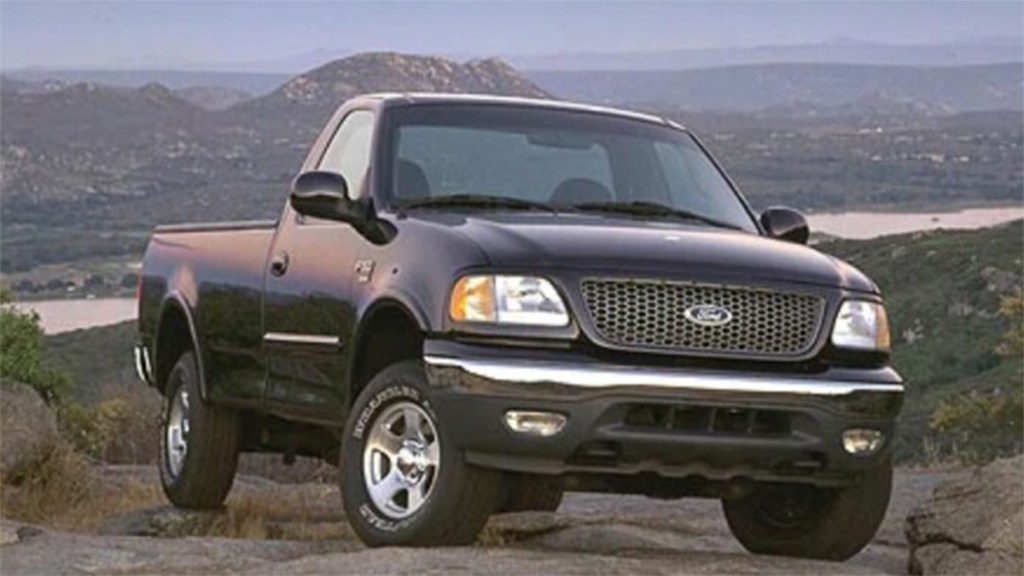
In 1997, Ford redesigned the F-150 from the ground up, and it would become one of the most controversial F-150s to date. Taking a page from the Ford Taurus playbook, Ford engineers rounded every corner of the previous generation, making an F-150 that bears almost no familial resemblance to its numerous predecessors. The traditional Twin I-Beam front suspension gets jettisoned and replaced by a fully independent setup. Just about every part — save for the transmission — is completely redesigned. The SuperCab adds a rear-hinged curbside door, followed a few years later by a matching door on the driver’s side.
This generation of the F-150 features a number of firsts, including the first 1/2-ton pickup CrewCab with full-size rear doors and the first Triton V8 engine featuring an overhead cam. The SVT trim returns in 1999 with a supercharged 5.4-liter engine, making an impressive 360 hp. All these upgrades and changes make the F-150 a much better truck, with better handling, a more comfortable cabin, and better fuel economy. Regrettably, this generation is plagued by several issues, including one of the most unsettling offset crash test performances ever recorded by the Insurance Institute for Highway Safety. (You can view the crash test video at iihs.org.)
Model Year Changes:
2003: New trims include the Heritage and STX.
2002: A new FX4 off-road package debuts, the King Ranch lineup expands, and the Harley-Davidson Edition gets a supercharged 5.4-liter V8.
2001: A 4-door SuperCrew debuts alongside the high-performance SVT Lightning.
2000: The Harley-Davidson Edition debuts.
1999: No major changes.
1998: Improvements to trim packages, options, and standard equipment make up the bulk of the changes.
See 1997 to 2003 Ford F-150 pickup trucks for sale near you.
The Early Years: 1973-1996
Throughout the 1970s and ’80s, the F-150 was known for its durable design, Twin I-Beam front suspension, and heavy hauling abilities. Many of these trucks are becoming collectibles, so prices are jumping up on older models. For someone shopping the used F-150 market, a 1992-1997 model might be the oldest we recommend. These trucks retain the traditional boxy shape that came to define the F-150 in previous decades, but they also mark the beginning of a more carlike interior. Features such as driver ‘s-side airbags, upgraded audio systems, and colorful interiors helped the F-150 stand out.
Buyers could opt for the sculpted FlareSide bed or the high-performance, 240 horsepower SVT Lightning. Cab configurations for this generation of the F-150 included Regular, SuperCab, and SuperCrew, and bed lengths ranged from 6.75 feet to 8 feet.
See classic Ford F-150 pickup trucks for sale near you.
What Is the Most Weight a Ford F-150 Can Tow and Haul?
The 2021 and newer Ford F-150s have a max trailer rating of up to 14,000 pounds and a maximum payload rating of 3,325 pounds. The 2015 F-150 max tow rating tops out around 12,200 pounds with a 3,300-pound payload. The 2014 F-150 with the 3.5-liter EcoBoost engine is tow rated at 11,300 pounds. Models from 2008 and earlier max out around 9,500 pounds.
RELATED: 7 Things You Need to Know About Towing Capacity
What Is the Difference Between a Ford F-150 and an F-250?
The F-150 is a regular 1/2-ton pickup, whereas the F-250 is a heavy-duty 3/4-ton truck. The F-250 offers more powerful engines, including Ford’s largest Power Stroke diesel engine, and can tow more weight. The F-250 has a more rugged suspension that yields a rougher ride, but the two trucks share a common cab.
What Is the Longest Bed I Can Get on an F-150 SuperCrew?
That depends on the trim and model year. High-end models like the Raptor and the Limited limit bed length to 5.5 feet, whereas the King Ranch and the Platinum stretch as far as 6.5 feet. Only Regular and SuperCab F-150s offer the 8-foot bed.
Are the Ford F-150s With Aluminum Body Panels Expensive to Repair?
This has been a nagging question ever since the 2015 F-150 debuted. From our research, shops that know how to work on aluminum panels spend no more time repairing them than they do repairing steel. Though aluminum panels might be new to the F-150, cars have been using them for far longer, so most body shops have the tools and skills to repair aluminum.
What Are the Issues to Watch Out for With a Ford F-150?
The 1997-2003 F-150s are the most trouble-prone, starting with a massive recall related to engine fires caused by a defective cruise control unit. There were some unusual complaints about the spark plugs on the 4.6-liter and 5.4-liter V8 engines blowing out from their seats. No recall was ever issued because no conclusive evidence indicated the exact cause. In fairness, most owners say that these F-150s have a reputation for longevity and relatively low maintenance costs — both important attributes to used car buyers.
Later-model F-150s hold up much better, but there are still some issues in 2004-2008 F-150s with spark plugs breaking off and corrosion issues on the hood and under the truck. This generation also had a lot of engine issues and recalls. Among the 2009-2014 trucks, the trouble-prone MyFord Touch system is a constant source of owner complaints. Some rear defrosters on the sliding rear window went bad, and there were numerous complaints about leaking gaskets and transmission shifting issues. The 2015 and newer models have held up well, although they, too, have a few recalls on the books and some reports of problems involving the electronic throttle body.
How Does the Ford F-150 Stack Up to the Competition?
Used Ford F-150 vs. Used Chevrolet Silverado
These rivals run neck and neck in almost every category, although the F-150 usually bests the Silverado in towing and payload. Over the various model years, however, the Silverado holds its value better and has fewer mechanical and electrical issues.
Used Ford F-150 vs. Used Ram 1500
Depending on the year, the Ram’s resale and reliability ratings fall short of the F-150’s. Newer Ram 1500 models offer more upscale interiors and smoother rides. The Ram 1500 was also quicker to get a diesel engine to market, and Ford has nothing to compete with the massive Ram Mega Cab.
Used Ford F-150 vs. Used Toyota Tundra
Though the Toyota Tundra can’t match the F-150 in towing, payload, engine choices, or trim levels, its reputation for being nearly bulletproof makes it a highly desirable full-size pickup. Resale and reliability ratings are consistently at the top of the charts, but the Tundra’s big V8 is notoriously fuel-thirsty, even on the newer models.
RELATED: Best Toyota Tundra Years to Buy Used
Is the Ford F-150 a Good Vehicle?
Yes, for the most part. The F-150 is a good truck with a long record of durability and repeat customers. We would avoid models made between 1997 and 2003, but even that can depend on the truck’s mileage and how it was cared for. Sure, there are issues in each generation, but when you sell 700,000 trucks a year, there will always be some that have problems.
So, while there might be a lot of complaints about various issues, the actual number of vehicles experiencing issues is relatively small, percentage-wise. Ford has been pretty good about addressing the most glaring problems through recalls or technical service bulletins. And considering how many F-150 buyers keep returning year after year, we think the Ford F-150 is an excellent used pickup.











